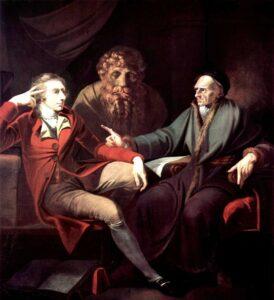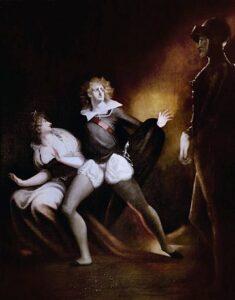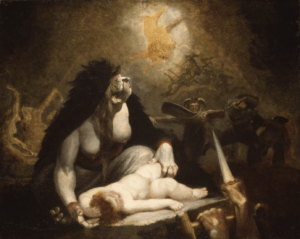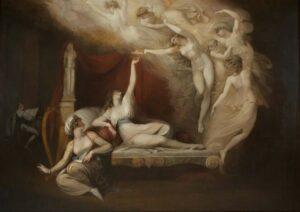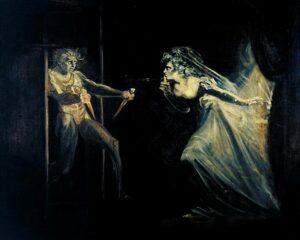The beginnings of a self-taught painter
He was born in Zurich and his father painted landscapes and portraits. He went to school in Zürich at the Collegium Carolinum and obtained a classical education. One of his best friends was Johann Caspar Lavater who became a poet and theoretician of physiognomy. In 1761 Füssli was ordained a pastor and had to leave Switzerland after publishing, along with J-C Lavater et Félix Hess, a pamphlet against a corrupted bailiff. He escaped Swiss justice into Germany.
There he met the Ambassador of Great-Britain who suggested he come to London, where he settled in 1764. He first made a living as a writer: he started translating a book by Winckelmann (1717-1798) on the influence of ancient Greek art, which had little success. After staying in Paris, where he met Jean-Jacques Rousseau, he published a book about him in London but it did not find an audience either.
In 1764, upon his arrival in London, Füssli was fascinated by the theatre and discovered David Garrick, a famous actor and stage director whose modern and dramatic acting thrilled him.
The painter Joshua Reynolds, then president of the Royal Academy of Arts, was interested in Füssli’s drawings and advised him to devote his life to painting and to go to Italy. Füssli stayed there for eight years, studied antique art and paintings by Titian, Caravaggio and mannerists. Füssli dedicated his studies to Michelangelo which left a lasting mark on his art. He even changed his name from ‘Füssli’ to ‘Fuesli’ to make it sound more Italian.
In 1779 he went back to London through Zurich where he painted for the Town Hall The oath on the Rütli, one of the founding myths of the Swiss Confederation.
A love for Michelangelo and Shakespeare
After settling down in London, Füssli, an admirer of Michelangelo and a friend of Winckelmann and William Blake (1757-1827), painted a hallucinatory piece featuring mixed macabre and magical themes.
He received an order from Boydell, a town counsellor who was organising ‘his Shakespeare gallery’. Füssli painted a lot of works for the patron, some of them were engraved and published in the English edition of Lavater’s Physiognomy. At the same time he helped the poet William Cowper translate Homer.
As he loved the theatre, especially Marlowe and Shakespeare, he painted emotionally intense canvasses. His works such as ‘Lady Macbeth sleepwalking ’ in 1784 and ‘Hamlet and his father’s ghost’ in 1793, show he was mesmerised by Macbeth, by ancient myths, by Biblical imagery, by Nordic legends and by Milton’s poetry, notably his ‘Paradise Lost’, but also by women adorned with fantastic hairstyles.
A well-known artist
In 1788 he was elected an associate member of the Royal Academy and married Sophia Rawlins, one of his sitters. Two years later on 10 February, 1790, Füssli was promoted to academician. At the time he offered ‘Thor fighting the Mitgard Snake’.
In 1799, Füssli was appointed as painting teacher at the Royal Academy. He resigned four years later when he was made an academy curator. His main work was a series of twelve talks at the Royal Academy (1801). In 1810 he resumed teaching until he died.
In 1817 Canova (1757-1822), the Italian sculptor, obtained the election of Füssli as a member of the prestigious Saint-Luke Academy.
Füssli died in a suburb of London. He rests in the crypt of Saint Paul’s Cathedral.
His work: dream and nightmare
Füssli explored the fantasy dream and nightmare world. Romantic artists were interested in the fantastic world, and the surrealists were fascinated by it. A world inhabited by witches, fairies, gnomes and demons incubus.
Füssli painted over two hundred pieces, but exhibited little. His first painting, Joseph Interpreting the Dreams of Pharaohs Baker and Butler, was the first to draw attention. He also painted, in a rather similar way, The Night-Hag Visiting Lapland Witches.
In 1782 he presented his most famous painting to this day: The Nightmare. Füssli painted several versions of it: in 1782 the first was a big success on its first presentation at the Royal Academy of Arts in London. Since 1950 it has been preserved at the Detroit Institute of Arts.
The painting was widely seen in engraving, thus ensuring its notoriety and prosperity. The canvas met critical acclaim but was also a contentious item.
Füssli expressed his fascination for the dream at multiple times in his paintings with great dramatic tension. He belonged to a new aesthetic called dark romanticism, as he developed his art through feminine representation, fantasy, terror and horror.
From a technical point of view, Füssli was a master of velatura, a technique that involves making colours – specifically white, one of the most opaque pigments – almost transparent. Thus the tunics and diaphanous veils in The Dream of Queen Katherine.
His work: Macbeth and Shakespeare’s dramas
Füssli created works based on an extensive literary repertoire, from Greek mythology to Nordic legends, from the Bible to English or German folklore, but also on Milton’s and Shakespeare’s works, which he copiously revisited. Füssli produced about eight hundred very original sketches or drawings.
From Shakespearian subjects to the representation of dreams and appearances, Füssli produced a new aesthetic. In his paintings he developed an oneiric and dramatic language by constantly mingling the wonderful and the fantastic, as well as the sublime and the grotesque.

